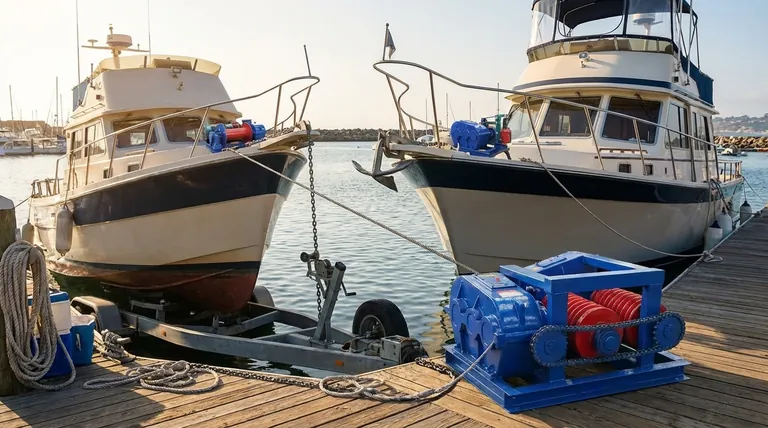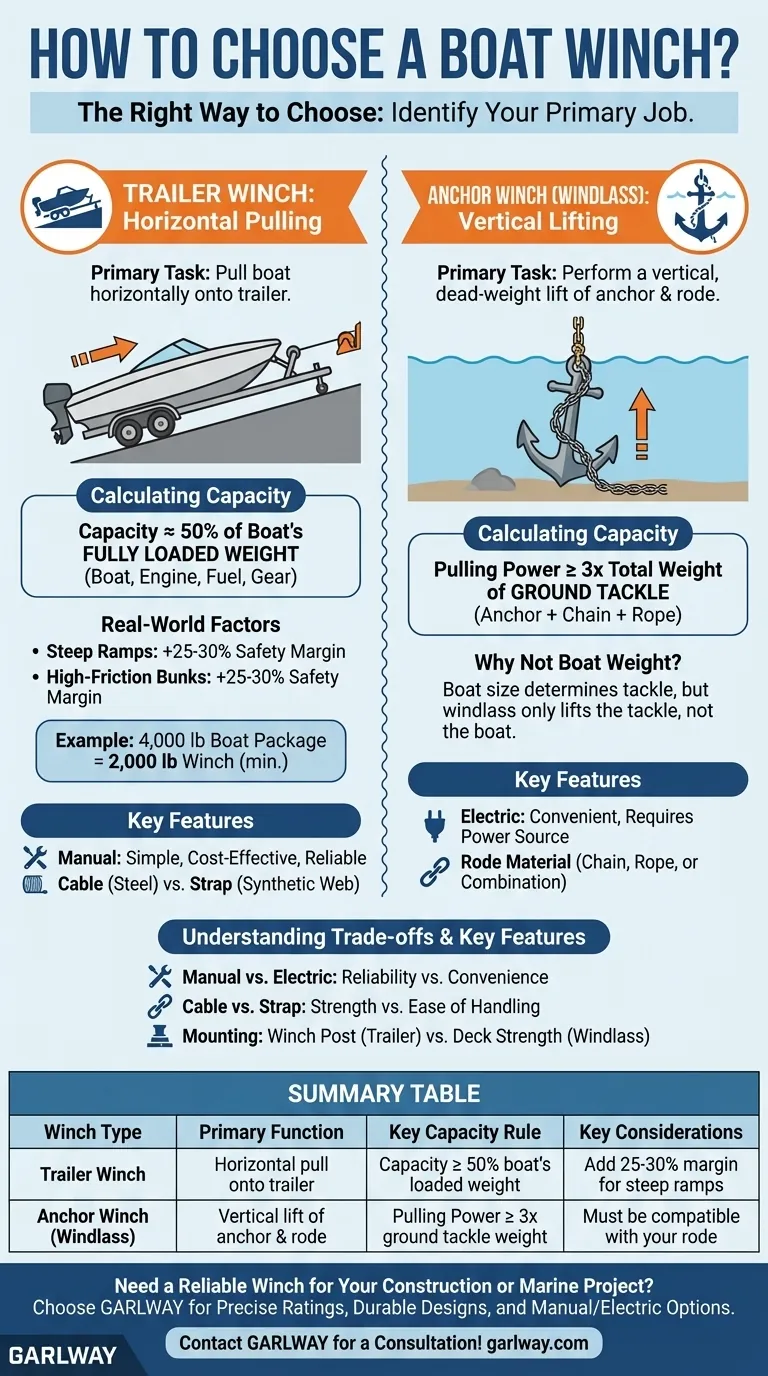The right way to choose a boat winch is to first identify its primary job, as the rules for a trailer winch are completely different from those for an anchor winch. For a trailer winch, capacity is based on your boat's weight, typically requiring a rating of about half the total weight. For an anchor winch (or windlass), capacity is based on lifting the anchor and its line, requiring a pulling power of three times the weight of your ground tackle.
Your boat's total weight is the critical factor for choosing a trailer winch, but it is almost entirely irrelevant when choosing an anchor winch. Understanding this distinction is the single most important step to selecting the correct equipment.

First, Identify Your Primary Task: Trailer or Anchor?
Before looking at ratings or features, you must be clear on the winch's function. These two tasks involve different physics, and the winches are not interchangeable.
The Trailer Winch: Horizontal Pulling
A trailer winch pulls your boat horizontally onto the trailer's bunks or rollers. It works against rolling friction and the incline of the boat ramp, not the boat's full dead weight.
This is why its rated capacity can be significantly less than the boat's actual weight.
The Anchor Winch (Windlass): Vertical Lifting
An anchor winch, properly called a windlass, does a completely different job. It performs a vertical, dead-weight lift of your anchor and rode (the chain and/or rope attached to it).
The force required is determined entirely by the weight of this "ground tackle," not the size or displacement of your boat.
Calculating Capacity for a Trailer Winch
For safely loading and unloading your boat from its trailer, a simple formula provides an excellent starting point.
The Core Formula
A widely used rule of thumb is that your trailer winch should have a capacity of at least half your boat's fully loaded weight. This includes the boat, engine, fuel, water, and all gear.
For example, a 4,000 lb boat package would require a 2,000 lb winch.
Factoring in Real-World Conditions
This formula assumes ideal conditions. You must account for variables that increase the required pulling force.
Steep boat ramps or high-friction bunks (instead of rollers) add significant resistance. For this reason, it is wise to add a 25-30% safety margin to your calculation.
Calculating Capacity for an Anchor Winch (Windlass)
Selecting a windlass uses a different calculation focused exclusively on the weight of your anchor system.
The Ground Tackle Rule
The standard marine formula is to choose a windlass with a maximum pulling power that is at least three times the total weight of your ground tackle.
Ground tackle includes the anchor itself plus the full weight of the chain and/or rope rode you have.
Why Not Boat Weight?
A common mistake is thinking a bigger boat needs a bigger windlass. The windlass only lifts the anchor system; the boat's engines are used to move the boat itself over the anchor before retrieval.
The boat's size (e.g., length and displacement) is mainly relevant for determining how heavy an anchor and rode you need in the first place, and for ensuring you have adequate deck space for the windlass.
Understanding the Trade-offs and Key Features
Once you've determined the correct capacity, consider the features that match your needs and boat setup.
Manual vs. Electric
A manual winch is simple, cost-effective, and highly reliable, making it perfect for smaller boats or as a backup.
An electric winch offers convenience at the push of a button but requires a reliable 12-volt power source, proper wiring, and a higher initial investment.
Cable vs. Strap
Most trailer winches use either a steel cable or a synthetic web strap. Steel is incredibly strong but can develop broken strands, rust, and kink. Straps are less likely to mar your boat's finish and are easy to handle.
Rode Material: Rope and Chain
For an anchor windlass, the winch must be compatible with your rode. Some are designed for all-chain rodes, while others can handle a combination of rope and chain.
Mounting and Compatibility
Ensure the winch can be securely mounted. For a trailer, this means a solid winch post. For a windlass, the boat's deck must be structurally strong enough to handle the high pulling forces involved.
Making the Right Choice for Your Goal
Use your primary objective to guide your final decision.
- If your primary focus is launching and retrieving your boat on a trailer: Calculate capacity as half your boat's loaded weight, then add a safety margin for steep ramps.
- If your primary focus is managing your anchor with ease: Calculate the total weight of your anchor and rode, then choose a windlass with a pulling power at least three times that amount.
- If your primary focus is budget and simplicity on a smaller boat: A manual winch for either trailering or anchoring offers unmatched reliability and low cost.
- If your primary focus is convenience and handling a larger vessel: An electric winch is essential, but be sure to account for its power and installation requirements.
Matching the winch's design and capacity to its specific job ensures safe, reliable, and stress-free operation.
Summary Table:
| Winch Type | Primary Function | Key Capacity Rule | Key Considerations |
|---|---|---|---|
| Trailer Winch | Horizontal pull onto trailer | Capacity ≥ 50% of boat's loaded weight | Add 25-30% safety margin for steep ramps |
| Anchor Winch (Windlass) | Vertical lift of anchor & rode | Pulling power ≥ 3x weight of ground tackle | Must be compatible with your rode (chain/rope) |
Need a Reliable Winch for Your Construction or Marine Project?
Choosing the right winch is critical for safety and efficiency. At GARLWAY, we specialize in heavy-duty construction machinery, including robust winches designed for demanding applications. Whether you're a construction company managing equipment or a contractor needing reliable pulling power, our winches deliver:
- Precise capacity ratings for your specific load requirements.
- Durable designs built to withstand tough job site conditions.
- Options for manual or electric operation to match your needs.
Let us help you select the perfect winch for your project. Contact GARLWAY today for a personalized consultation and quote!
Visual Guide

Related Products
- Electric 120V Boat Winch by Badlands
- Electric Hoist Winch Boat Anchor Windlass for Marine Applications
- Heavy Duty Electric Boat Winch Windlass Anchor
- Warn Winch Windlass Boat Trailer Winch
- 12000 lb Heavy Duty Electric Boat Winch
People Also Ask
- How much current does an electric boat winch draw? Plan Your Electrical System for Peak Performance
- What are marine electric winches and their characteristics? Key Features for Reliable Maritime Operations
- How does the boat launch ramp condition affect winch selection? Ensure Safe Retrieval on Any Ramp
- What are the power source options for electric winches? Choose the Right Power for Your Job
- How to pick a boat winch? Choose the Right Trailer or Anchor Winch for Your Boat














